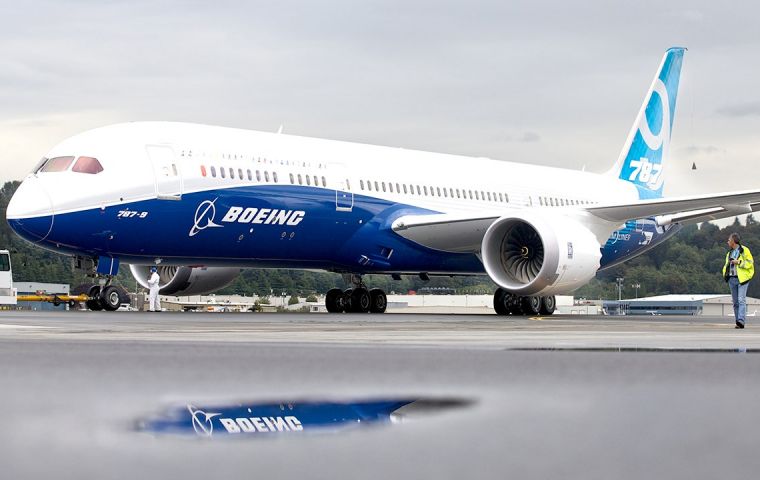MercoPress. South Atlantic News Agency
The new Boeing model facing security issues
 Scrutiny by the FAA has also sought to avoid leaving factory debris inside the planes
Scrutiny by the FAA has also sought to avoid leaving factory debris inside the planes Aircraft manufacturer Boeing keeps coming across unexpected hurdles. Now they have detected a quality problem with the 787 Dreamliner model, which has led to delays in the delivery of the newer units, in addition to drawing increased scrutiny from the Federal Aviation Administration (FAA).
According to the Wall Street Journal, the new issue affects certain titanium parts that, as a result of a defect, are weaker than required by the design and would only affect units built in the last three years, which means it “does not pose a risk to the safety of the aircraft currently operating.”
However, the company proceeded to carry out repairs on two aircraft - not yet delivered - that would have had to remain on the ground because they contained a high number of these weak parts. According to company sources, Boeing does not plan to resume Dreamliners deliveries until November at the earliest. A company spokesperson noted that “Boeing is making improvements to the production process, raising its standards despite operational disruptions. We have reinforced our attention to quality.”
The novel 787 began in late 2020 after small gaps were discovered between sections of the plane that could lead to premature material fatigue. Because of this, the FAA removed Boeing's ability to self-approve its aircraft and issue its certificates of airworthiness. While the Administration finds Boeing's attempts to address production problems “encouraging”, this still does not meet the agency's requirements.
The FAA informed Boeing that it “had been delayed in resolving 48 points reported in September that affected several aircraft.” According to the agency, “said aircraft did not meet the standards mandated by federal regulations.” The problems are related to various elements such as the thickness of the paint or the strength of the bond between the windshield and the fuselage. According to industry sources, Boeing would have solved more than a quarter of the problems.
Scrutiny by the FAA has also sought to avoid leaving factory debris inside the planes. By early 2020, remnants of the manufacturing process had been found in nearly two-thirds of the fuel tanks of the 737 MAX aircraft manufactured. These items - including tools and rags - could affect flight safety. Despite this, Boeing noted that during 2020 it had managed to reduce total foreign objects by 60% compared to the previous year.
The new announcements on the Dreamliner are believed to have an impact on Latam Airlines, Avianca and Aeroméxico, which operate the model in the region. Latam owns 26 Boeing 787s, Aeroméxico 15 and Avianca 14. The Boeing 787 Dreamliner also makes up the bulk of the long-haul fleet of Air Europa (Globalia), which serves several Latin American destinations from Madrid.
The new defects in the 787 Dreamliner came after production problems with the 737 MAX at the end of 2020, which grounded the entire output for almost two years until a solution was found to the problems resulting in two accidents and 346 deaths.
Despite the latest developments, Boeing released its aircraft delivery report for the third quarter of this year on Tuesday. In turn, the company also announced its financial data will be published on Oct. 27. In an institutional statement, the company said that “we have made significant progress towards stability in all our operations.”
Among the deliveries, the increase in the pace with which the 737 MAX left the factory of the American giant stands out: Boeing delivered 62 units in the period, an increase of 31% compared to the previous quarter (47 aircraft passed to their operators between April and June). In total, 66 units of the 737 model were received by their operators, as four P-8 Poseidons were also delivered in the period, including the first for the Norwegian Air Force.
On the other hand, Boeing remarked that “we continue to thoroughly inspect the 787 production system and its supply chain. In the meantime, we are in constant contact with the FAA and the program providers. Due to the focus of our resources on inspection and quality control, the production rate of the model continues to be less than five aircraft per month. ”
Perhaps also due to the 787 crisis, Air New Zealand has introduced the 787 “Jabaseat”, a Business Class Vaccination Center thanks to which a Dreamliner was converted into a vaccination clinic this weekend in a celebration called “Super Saturday,” and was a part of a campaign by the carrier to demand international passengers be fully vaccinated against COVID-19, under the slogan “no jab, no-fly”. New Zealand hopes to open its borders by 2022.
Always under the strictest of protocols, “passengers” boarded through the main door of the Business Premier section, where they received the first dose of the Pfizer vaccine, after which they were offered a snack and beverage service at the economy class.




Top Comments
Disclaimer & comment rulesCommenting for this story is now closed.
If you have a Facebook account, become a fan and comment on our Facebook Page!